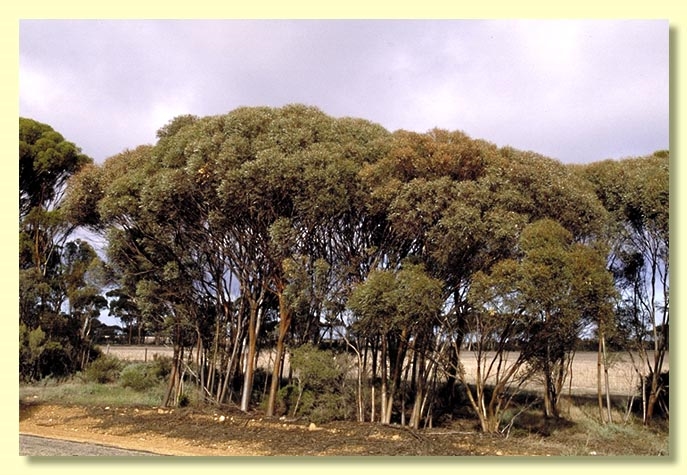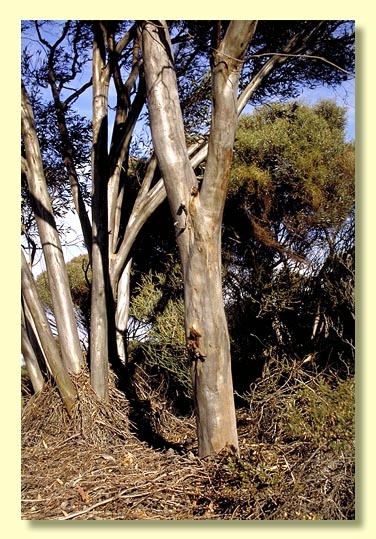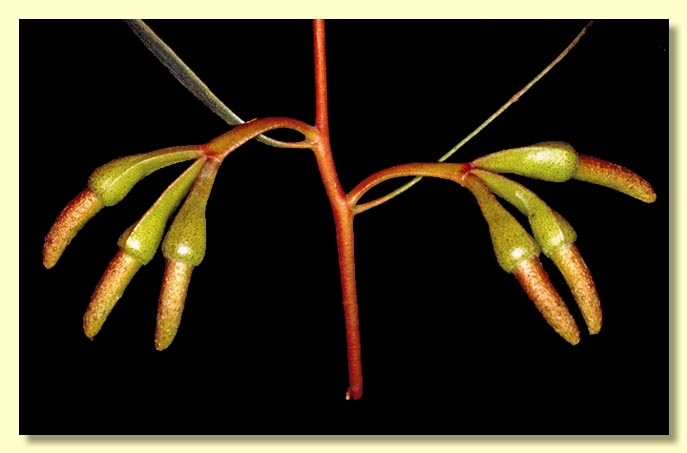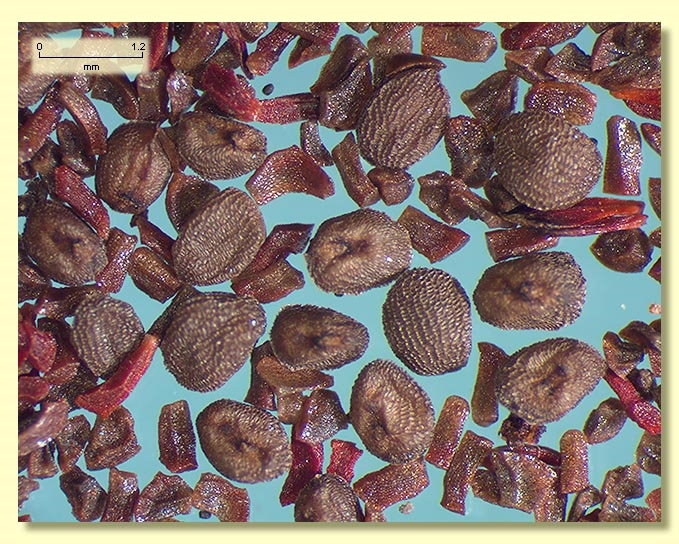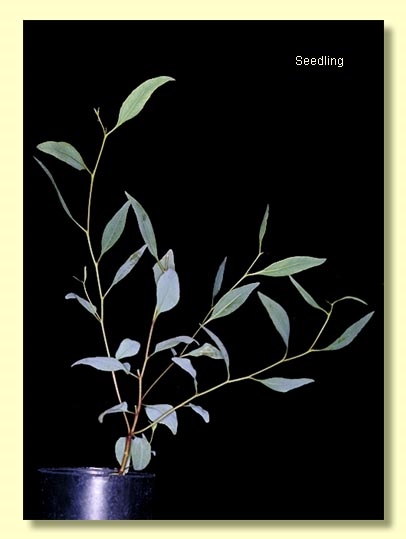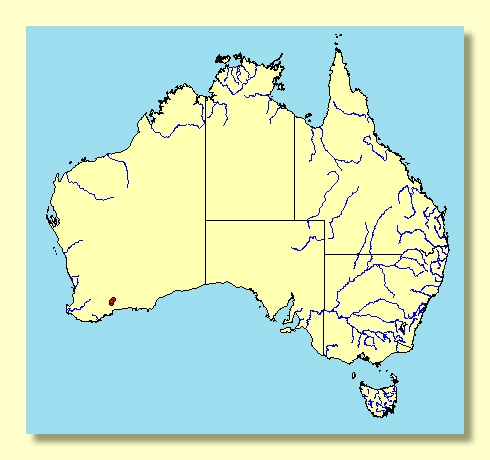Eucalyptus | Symphyomyrtus | Bisectae | Glandulosae | Erectae | Abundae
Euclid - Online edition
Eucalyptus goniocarpa
Bark smooth throughout, grey and pale tan to coppery.
Branchlets with oil glands in the pith.
Juvenile growth (coppice or field seedlings to 50 cm): stems squared to rounded in cross-section, warty on lowest part but mostly smooth, non-glaucous or with slight waxy bloom; leaves opposite at first node but soon alternate on stem, petiolate, lanceolate, 4.5-8.7 cm long, 1.3-2.5 cm wide, base tapering to petiole, apex pointed, margin entire, green to grey-green.
Adult leaves more or less erect, alternate, petioles 0–0.8 cm long; blade narrowly elliptic to linear, (3.5)4.5–9.5 cm long, 0.5–1.2 cm wide, base tapering to petiole, margin entire or distantly notched, apex pointed, concolorous, green, glossy, surface appearing "glazed", side veins acute or obscure, reticulation and intramarginal vein obscure, oil glands numerous, island.
Inflorescence axillary unbranched, peduncles flattened, usually at least partly downturned, 1.2–3 cm long, buds 3(7) per umbel, pedicellate (pedicels (0.2)0.5–1 cm long). Mature buds elongated, 2–2.5 cm long, 0.6–0.8 cm wide (assymetrically fusiform but with hypanthium slightly wider than the operculum at the join), scar present (outer operculum shed early), inner operculum narrowly conical (tending to horn-shaped), slightly warty or smooth, stamens erect, anthers oblong, versatile, dorsifixed, dehiscing by longitudinal slits, style long and straight, stigma blunt to slightly dilated, locules 4, the placentae each with 4 vertical rows of ovules. Flowers white-cream.
Fruit pedicellate (pedicels (0.2)0.4–1.2 cm long), barrel-shaped to obconical with ribs or narrow wings extending from upper hypanthium down the pedicels, (1.0)1.2–1.4 cm long, 0.9–1.2 cm wide, disc descending, obscured by persistent staminophore, valves 4, the tips at about rim level.
Seeds dark brown to grey-brown, 1–2 mm long, ovoid to flattened-ovoid, dorsal surface clearly and shallowly reticulate, hilum ventral.
Cultivated seedlings (measured at node 10): cotyledons Y-shaped (bisected); stems rounded in cross-section, warty; leaves always shortly petiolate, opposite for 2 to 4 nodes then alternate, ovate or narrowly so, 4.5–7 cm long, 1.3–2.5 cm wide, dull, grey-green to green. Leaves feel slightly rough when fresh, at least until ca node 11, due to warts or short coarse bristles.
Flowering time unknown.
A short-trunked mallet species endemic to Western Australia, restricted to the Lake King, Hatter Hill, Ravensthorpe area where it occurs in small pure stands on low-lying sites. The stems are smooth, the adult leaves glossy, olive-green with venation obscured by oil glands, and the buds are in threes.
Eucalyptus goniocarpa belongs in Eucalyptus subgenus Symphyomyrtus section Bisectae subsection Glandulosae because the buds have an operculum scar, cotyledons are bisected and branchlets have oil glands in the pith. Within this large subsection (ca 80 species) E. goniocarpa is closely related to a group of mallees and mallets (series Erectae subseries Abundae) recognised by the "glazed", green leaf surface, leaves with a great density of oil glands that obscures the venation, peduncles long and flattened, inflorescences spreading to pendulous and buds with a long operculum and erect stamens.
The three-budded inflorescence and the presence of two narrow wings extending from the pedicel onto either side of the base of the bud (and persisting in fruit) separate E. goniocarpa from E. eremophila and relatives (E. tenera, E. tephroclada, E. depauperata and E. incerata). These same characters suggest a relationship between E. goniocarpa and E. alipes with the latter having similar but smaller buds with a much shorter operculum and smaller leaves. Other species in this group having winged buds—E. steedmanii and E. mimica—have four more or less prominent wings or ribs instead of two, and an outer operculum that either splits to form persistent sepals or remains entire and unshed until flowering.
E. goniocarpa may be the same as E. eremophila subsp. pterocarpa Blakely & Steedman, but this subspecies, based on a 1938 collection by Steedman, was reported as growing "among rocks" near Hatter Hill, a habitat quite unlike that of the known populations of E. goniocarpa and may therefore be another, perhaps 'lost', subspecies. For further notes see also K.D.Hill & L.A.S.Johnson, Telopea 4: 584 (1992).
Footnote.
Malcolm French (2013) in his book "Eucaltypts of Western Australia's wheatbelt" states on page 72 that E. eremophila subsp. pterocarpa has recently been rediscovered at its original locality.

